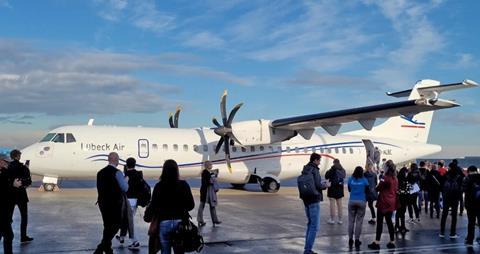European researchers have concluded – perhaps unsurprisingly – that noise and vibration are the biggest sources of passenger discomfort in turboprop aircraft.
And they stress that such issues must be addressed as the aviation industry switches to propeller-driven designs as part of a move to new power sources for regional flight.

Noting that while there are a combination of factors weighing on cabin comfort – several of which are interrelated – researchers suggest that tackling turboprop noise should be a priority.
The paper, Aircraft interior and seat design: priorities based on passengers’ opinions, says “the impact of noise on discomfort is shown to be very large in a turbo-propeller airplane and on longer flights (more than 70min) this impact might be even larger.
“It is wise to treat noise with higher importance and first reduce the noise to a level mostly influencing comfort and not discomfort.”
In the study, funded by the EU’s Clean Sky 2 programme, researchers from three universities – Delft University of Technology in the Netherlands, Ludwig Maximilian University of Munich, and Nottingham Trent University in the UK – performed two experiments to assess passenger opinions on cabin comfort.
In the first, 33 passengers were ‘carried’ on a 70min simulated flight in a Boeing 737 – with turboprop noise projected into the cabin. A total of 30 passengers were located in seats with a 31in pitch, while three were positioned in front-row seats with additional legroom.
Passengers were surveyed three times during the ‘flight’, and asked to list the three factors which most contributed to their discomfort from temperature, noise, lighting, air quality, vibration, seat and space. The same survey was conducted three times for comfort factors.
For the second experiment, two 70min flights, with respectively 52 and 45 passengers aboard, were performed using an ATR 72-500 supplied by German regional carrier Lubeck Air (D-ALBC). Passengers were sat in a 2-2 layout in seats with a 35in pitch. Both flights included a 30min period at a cruising altitude of 17,000ft.
After the flights, the participants were surveyed and asked to list their top three factors influencing both discomfort and comfort.
In the simulated flight, noise – cited by over 70% of passengers – was the dominant factor influencing discomfort, followed by seating and space. In contrast, temperature was the leading factor for comfort, followed by light and seating.
Noise was identified as the chief cause of discomfort for passengers aboard the turboprop flights – cited by 91% of respondents – followed by vibration (63%) and the seat (51%); space, light and temperature were the top three comfort factors, meanwhile.
“It seems that in turboprops the noise is the factor that needs most attention,” says the study, citing previous research which concluded that it can both increase the awareness of symptoms, such as a headache, and also “cause differences in comfort experience and mood”.
Potential solutions for future propeller aircraft include active structural acoustic control and engine synchronisation, plus the use of noise-dampening material and even noise-cancelling headphones for passengers.
Mechanical options include changing the harmonic frequency by altering the number of propeller blades or changing the position of the propellers so “there is less aerodynamic interaction with the rest of the airframe”.
Vibration could be tackled through the use of advanced materials in the seat structure and cushion, it says: “New designs that have vibration absorption capabilities with lighter sustainable materials might improve the passengers’ comfort in the sustainable aviation of the future.”


























